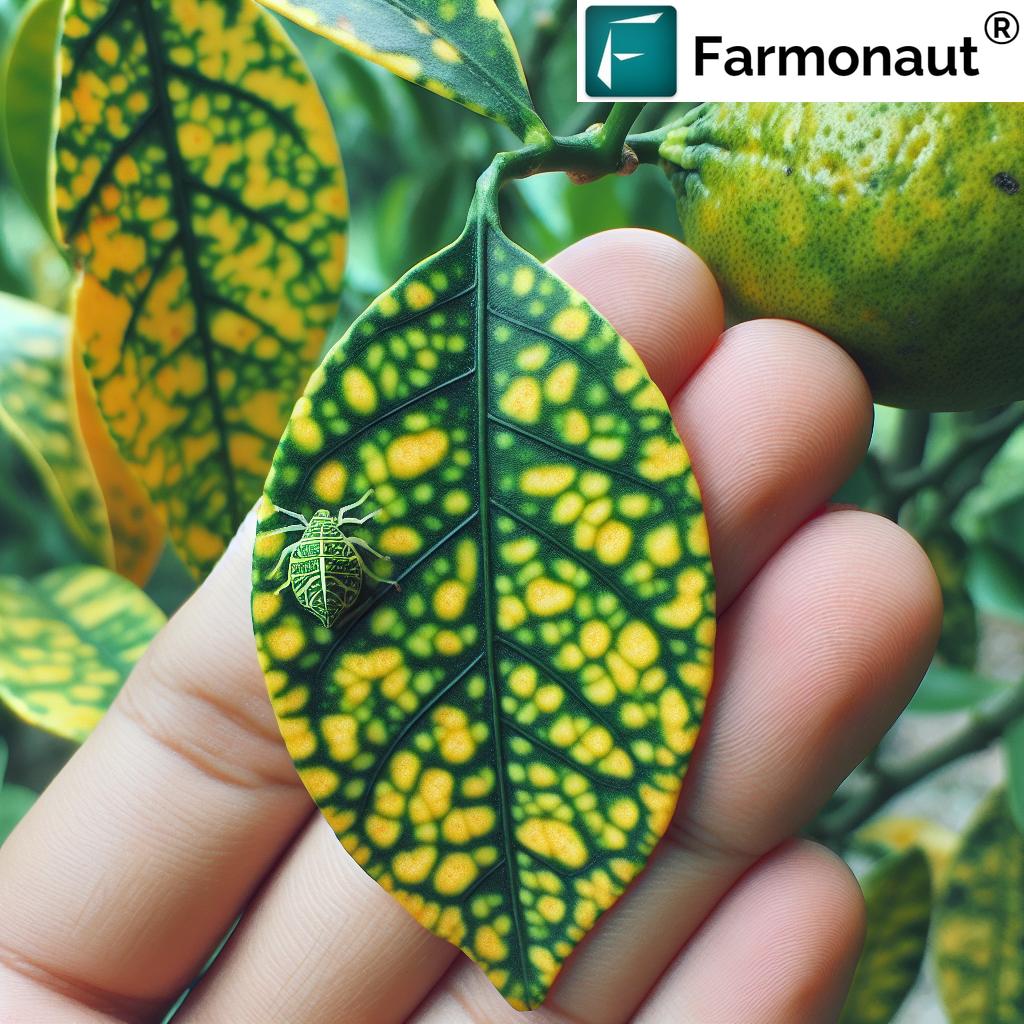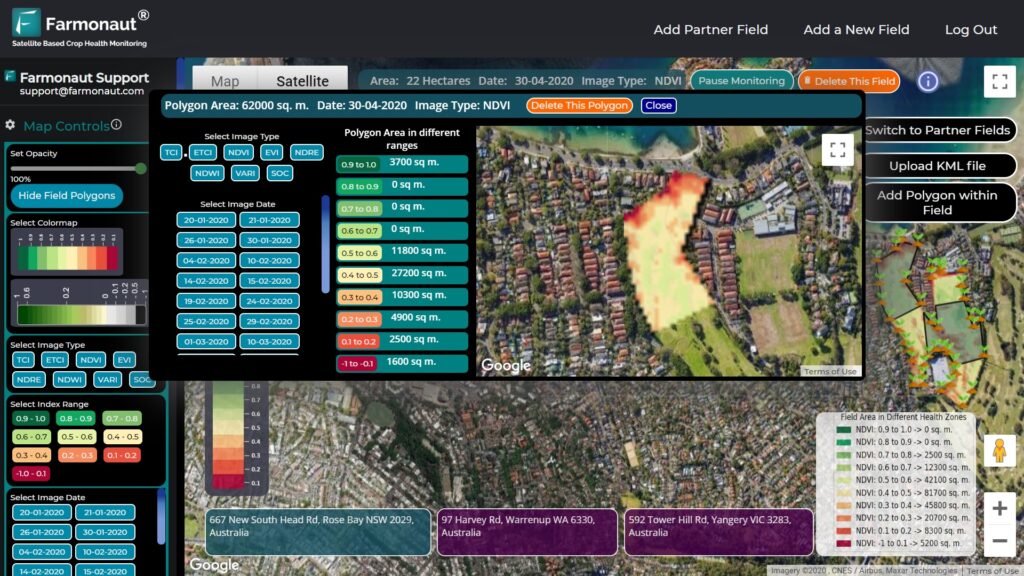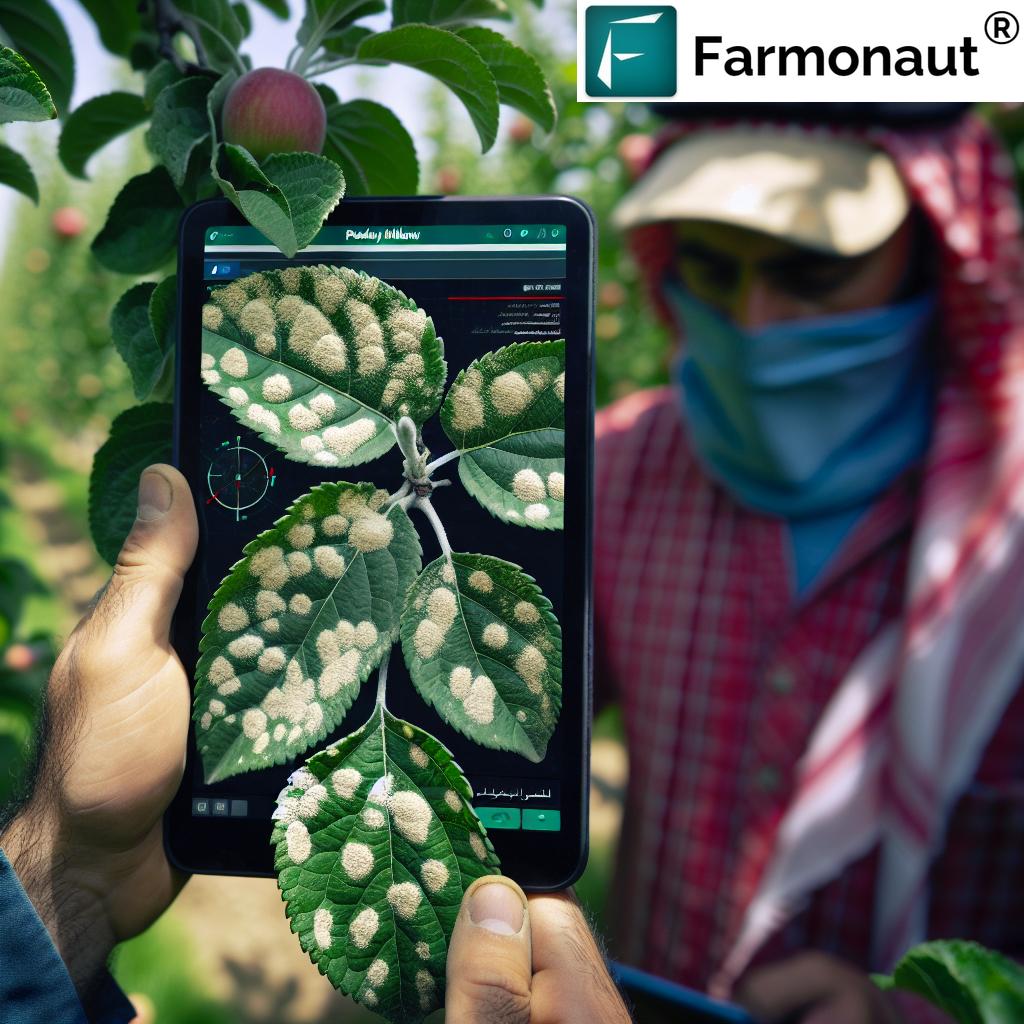Citrus Greening Disease: Symptoms, Control, and Organic Farming Solutions for Infected Trees

As experts in agricultural technology and crop health monitoring, we at Farmonaut understand the devastating impact of citrus greening disease on orchards worldwide. This comprehensive guide will delve into the intricacies of this destructive disease, its symptoms, and the various control methods available to citrus farmers. We’ll explore both conventional and organic farming approaches to combat this menace, with a special focus on how our satellite-based monitoring system can revolutionize early detection and management strategies.
Understanding Citrus Greening Disease
Citrus greening, also known as Huanglongbing (HLB) or yellow dragon disease, is one of the most serious citrus plant diseases in the world. It is caused by a bacteria called Candidatus Liberibacter asiaticus and is spread by a tiny insect called the Asian citrus psyllid (Diaphorina citri).
The Devastating Impact on Citrus Industry
Citrus greening has had a profound impact on the global citrus industry, causing billions of dollars in losses. The disease affects all varieties of citrus trees, including oranges, lemons, limes, and grapefruits. Once a tree is infected, there is no cure, and the tree will ultimately die. This has led to widespread destruction of citrus orchards in many parts of the world, particularly in Asia, Africa, and the Americas.
Symptoms of Citrus Greening Disease
Identifying the symptoms of citrus greening early is crucial for managing its spread. Here are the key symptoms to look out for:
- Leaf Discoloration: One of the most noticeable symptoms is the yellowing of leaf veins and adjacent tissues. This creates a mottled or blotchy appearance on the leaves.
- Asymmetrical Leaf Mottling: The yellowing pattern is often asymmetrical across the leaf’s midrib, which is a distinctive feature of citrus greening.
- Stunted Growth: Infected trees often exhibit stunted growth and sparse foliage.
- Fruit Deformation: Fruits from infected trees may be small, lopsided, and poorly colored. They often remain green at the bottom (hence the name “greening”).
- Premature Fruit Drop: Infected trees may experience excessive fruit drop before the fruits are ripe.
- Bitter Taste: Fruits from infected trees often have a bitter, medicinal taste.
- Twig Dieback: As the disease progresses, twigs begin to die back from the tip, leading to overall tree decline.

The Asian Citrus Psyllid: The Carrier of Destruction
The Asian citrus psyllid (Diaphorina citri) plays a crucial role in the spread of citrus greening disease. Understanding this pest is essential for developing effective control strategies.
Characteristics of the Asian Citrus Psyllid
- Appearance: Adult psyllids are small, about 3-4 mm long, with mottled brown wings. They often sit at a 45-degree angle when resting on leaves.
- Life Cycle: The psyllid goes through egg, nymph, and adult stages. The entire life cycle can be completed in 15-47 days, depending on environmental conditions.
- Egg Laying: Female psyllids lay tiny, almond-shaped eggs on the tips of growing shoots or in the crevices of unfolded leaves.
- Nymph Stage: Nymphs are yellowish-orange in color and produce waxy tubules that help in their identification.
How Psyllids Spread Citrus Greening
The Asian citrus psyllid acquires the bacteria responsible for citrus greening when feeding on infected plants. Once a psyllid carries the bacteria, it can transmit it to healthy trees in as little as 15 minutes of feeding. This rapid transmission makes controlling the spread of the disease extremely challenging.
Conventional Control Methods for Citrus Greening
In conventional farming systems, several methods are employed to control citrus greening disease:
1. Chemical Control of Psyllids
The primary method of controlling citrus greening in conventional systems is through the use of insecticides to manage psyllid populations. This typically involves:
- Foliar Sprays: Regular application of approved insecticides to control adult psyllids.
- Soil Drenches: Systemic insecticides applied to the soil to be taken up by the tree, providing longer-term protection.
- Trunk Injections: Direct injection of insecticides into the tree trunk for systemic protection.
2. Removal of Infected Trees
Once a tree is confirmed to be infected with citrus greening, it is often recommended to remove and destroy the tree to prevent further spread of the disease.
3. Quarantine Measures
Implementing strict quarantine measures to prevent the movement of infected plant material or psyllids to unaffected areas.
4. Nutritional Support
Enhanced nutrition programs are often implemented to support the health of infected trees and potentially extend their productive lifespan.
Organic Farming Approaches to Citrus Greening Control
For organic citrus farmers, controlling citrus greening presents unique challenges, as many conventional control methods are not permitted. However, several organic approaches can be effective:
1. Biological Control
Utilizing natural predators of the Asian citrus psyllid is a key strategy in organic farming systems. This includes:
- Parasitic Wasps: Tamarixia radiata is a tiny wasp that parasitizes psyllid nymphs.
- Predatory Insects: Ladybugs, lacewings, and syrphid flies are natural predators of psyllids.
- Entomopathogenic Fungi: Certain fungi can infect and kill psyllids, providing natural control.
2. Cultural Practices
Implementing specific cultural practices can help reduce the impact of citrus greening:
- Pruning: Regular pruning to remove infected branches and promote new growth.
- Nutrient Management: Ensuring proper nutrition through organic fertilizers to boost tree health and resistance.
- Intercropping: Planting companion crops that repel psyllids or attract beneficial insects.
3. Organic Pesticides
While options are limited, some organic-approved pesticides can be effective against psyllids:
- Neem Oil: Acts as a repellent and can disrupt psyllid feeding and reproduction.
- Pyrethrin: Derived from chrysanthemum flowers, it can provide short-term control of adult psyllids.
- Spinosad: A naturally derived substance that can be effective against psyllid nymphs and adults.
4. Thermotherapy
Some organic growers have experimented with heat treatments to reduce bacterial loads in infected trees. This involves encasing trees in plastic tents and applying heat for extended periods.
The Role of Advanced Technology in Citrus Greening Management
At Farmonaut, we believe that advanced technology plays a crucial role in the early detection and management of citrus greening. Our satellite-based monitoring system offers several advantages over traditional monitoring methods:
| Feature | Traditional Monitoring | Farmonaut Satellite System |
|---|---|---|
| Early Detection | Relies on visual inspection, often detecting symptoms when disease is advanced | Can detect subtle changes in plant health before visual symptoms appear |
| Coverage Area | Limited to areas that can be physically accessed and inspected | Can monitor vast areas of citrus groves simultaneously |
| Frequency of Monitoring | Typically monthly or quarterly, depending on resources | Continuous monitoring with regular updates (daily to weekly) |
| Cost-effectiveness | Labor-intensive and time-consuming, especially for large orchards | Highly cost-effective, reducing the need for frequent on-ground inspections |
Benefits of Farmonaut’s Satellite Monitoring for Citrus Greening Management
- Early Detection: Our advanced algorithms can detect subtle changes in plant health indicators, potentially identifying infected trees before visual symptoms appear.
- Precise Mapping: We provide detailed maps of orchards, highlighting areas of concern for targeted inspection and treatment.
- Historical Data Analysis: Our system allows for the comparison of current data with historical trends, helping to identify patterns and predict disease spread.
- Integration with Other Data: We combine satellite imagery with weather data and other relevant information to provide comprehensive insights for disease management.
To learn more about how Farmonaut can help you manage citrus greening in your orchard, visit our application page or explore our API documentation for integration with your existing systems.
Integrated Pest Management (IPM) for Citrus Greening
An effective strategy against citrus greening involves integrating various control methods into a comprehensive management plan. This approach, known as Integrated Pest Management (IPM), combines biological, cultural, physical, and chemical tools in a way that minimizes economic, health, and environmental risks.
Key Components of an IPM Strategy for Citrus Greening
- Monitoring and Detection: Regular scouting for psyllids and symptoms of citrus greening, supplemented by advanced technologies like Farmonaut’s satellite monitoring system.
- Cultural Controls: Implementing best practices in orchard management, including proper irrigation, nutrition, and pruning.
- Biological Controls: Encouraging and introducing natural enemies of the Asian citrus psyllid.
- Chemical Controls: Judicious use of insecticides when necessary, with a focus on timing applications to maximize effectiveness and minimize environmental impact.
- Regulatory Measures: Adhering to quarantine regulations and best practices for preventing the spread of the disease.
- Education and Outreach: Ensuring that all stakeholders, from farm workers to neighboring property owners, are educated about the disease and control measures.
The Future of Citrus Greening Management
As we continue to battle citrus greening disease, research into new management strategies and potential cures is ongoing. Some promising areas of research include:
- Genetic Engineering: Developing citrus varieties that are resistant to the disease or the psyllid vector.
- RNA Interference: Using RNAi technology to disrupt the psyllid’s ability to transmit the bacteria.
- Antimicrobial Compounds: Investigating natural and synthetic compounds that can combat the bacteria within infected trees.
- Advanced Biocontrol Agents: Developing more effective predators and parasites of the Asian citrus psyllid.
- Nanotechnology: Exploring the use of nanoparticles for targeted delivery of treatments within infected trees.
Case Study: Implementing Farmonaut’s Technology in a Florida Citrus Grove
To illustrate the practical application of our satellite monitoring system, let’s consider a hypothetical case study of a 1000-acre citrus grove in Florida:
Background:
The grove had been struggling with citrus greening for several years, with traditional monitoring methods failing to catch the disease in its early stages. The farm manager decided to implement Farmonaut’s satellite monitoring system to improve early detection and management.
Implementation:
- The farm subscribed to Farmonaut’s monitoring service, which began providing weekly updates on vegetation health across the entire grove.
- The farm’s GIS data was integrated with Farmonaut’s system to create precise maps of the orchard layout.
- Farm staff were trained to use the Farmonaut mobile app for field verification of satellite-detected anomalies.
Results:
- Within the first month, Farmonaut’s system identified several areas of potential infection that had been missed by visual inspections.
- Targeted inspections of these areas confirmed early-stage infections, allowing for prompt removal of infected trees before the disease could spread further.
- Over six months, the farm saw a 30% reduction in new infections compared to the previous year.
- The ability to monitor the entire grove consistently led to more efficient use of resources, with spraying and inspections now focused on high-risk areas identified by the satellite data.
Long-term Impact:
By implementing Farmonaut’s technology as part of a comprehensive IPM strategy, the grove was able to significantly slow the spread of citrus greening, maintain higher productivity, and reduce overall management costs.
Best Practices for Citrus Growers
Based on our experience and the latest research, we recommend the following best practices for citrus growers dealing with the threat of citrus greening:
- Implement a Robust Monitoring System: Utilize advanced technologies like Farmonaut’s satellite monitoring alongside regular ground inspections to catch infections early.
- Maintain Orchard Hygiene: Regularly remove dead wood, fallen fruit, and other debris that can harbor pests and diseases.
- Optimize Tree Health: Ensure proper nutrition and irrigation to boost tree immunity and resilience against disease.
- Coordinate with Neighbors: Work with neighboring citrus growers to implement area-wide management strategies for psyllid control.
- Stay Informed: Keep up-to-date with the latest research and recommendations from agricultural extension services and industry associations.
- Plan for the Long-term: Consider diversifying citrus varieties and exploring alternative crops to build resilience against potential losses.
- Embrace Technology: Utilize tools like Farmonaut’s mobile app (Android, iOS) for real-time monitoring and decision support.
The Economic Impact of Citrus Greening
The economic consequences of citrus greening disease are far-reaching and severe. Understanding these impacts is crucial for growers, policymakers, and researchers working to combat this devastating disease.
Direct Costs to Growers
- Reduced Yield: Infected trees produce fewer and lower-quality fruits, directly impacting grower income.
- Increased Management Costs: The need for intensive monitoring, frequent pesticide applications, and enhanced nutritional programs significantly increases production costs.
- Tree Replacement: The cost of removing infected trees and replanting with healthy stock is substantial.
Industry-wide Effects
- Market Instability: Fluctuations in citrus supply due to greening have led to price volatility in both fresh fruit and juice markets.
- Job Losses: Reduced production has led to job losses in citrus farming, processing, and related industries.
- Research and Development Costs: Significant resources are being directed towards finding solutions to citrus greening, diverting funds from other agricultural research areas.
Global Trade Implications
- Export Restrictions: Many countries have imposed restrictions on citrus imports from regions affected by greening, impacting international trade.
- Shift in Production Centers: As traditional citrus-growing regions struggle with the disease, production is shifting to new areas, altering global trade patterns.
The Role of Government and Industry Organizations
Combating citrus greening requires a coordinated effort from various stakeholders. Government agencies and industry organizations play crucial roles in managing the disease:
Government Initiatives
- Research Funding: Allocating resources for scientific research into disease management and potential cures.
- Regulatory Measures: Implementing and enforcing quarantine regulations to prevent disease spread.
- Support Programs: Providing financial assistance to affected growers and supporting industry transition efforts.
Industry Organizations
- Coordination: Facilitating cooperation between growers, researchers, and policymakers.
- Education: Providing training and resources to help growers implement best management practices.
- Advocacy: Representing the interests of citrus growers in policy discussions and funding decisions.
Leveraging Technology for Comprehensive Orchard Management
While our focus has been on citrus greening, it’s important to note that effective orchard management requires a holistic approach. Farmonaut’s technology offers tools that go beyond disease detection to support overall orchard health and productivity:
1. Precision Irrigation Management
Our satellite-based soil moisture monitoring helps optimize irrigation schedules, ensuring trees receive the right amount of water at the right time. This not only conserves water but also helps maintain optimal tree health, potentially increasing resistance to diseases like citrus greening.
2. Nutrient Management
By analyzing vegetation indices, we can help identify areas of nutrient deficiency or excess, allowing for targeted fertilizer applications. This precision approach can improve tree health while reducing unnecessary fertilizer use.
3. Yield Estimation
Our advanced algorithms can provide early yield estimates, helping growers and the industry plan for harvesting, processing, and marketing.
4. Climate Risk Assessment
By integrating historical climate data with real-time monitoring, we can help growers assess and mitigate risks associated with extreme weather events, which can exacerbate disease pressures.
To explore how these features can benefit your orchard management, visit our API documentation for detailed information on integrating our technology into your existing systems.
The Future of Citrus Farming
As we look to the future, it’s clear that the citrus industry must continue to evolve and adapt to meet the challenges posed by citrus greening and other threats. Here are some key trends and developments we anticipate:
1. Increased Adoption of Technology
We expect to see widespread adoption of advanced technologies like satellite monitoring, AI-driven decision support systems, and precision agriculture tools. These technologies will be crucial in managing diseases, optimizing resource use, and maintaining profitability.
2. Development of Resistant Varieties
Ongoing research into genetically modified or selectively bred citrus varieties resistant to citrus greening could dramatically change the landscape of citrus farming.
3. Shift towards Sustainable Practices
With increasing consumer demand for sustainably produced food, we anticipate a greater emphasis on organic and eco-friendly farming practices, even in conventional citrus production.
4. Diversification of Production
To mitigate risks associated with citrus greening, many growers may diversify their crops, potentially leading to new citrus-growing regions and changes in traditional citrus landscapes.
5. Integration of Vertical Farming
While not suitable for all citrus production, protected cultivation methods, including advanced greenhouse systems and even vertical farming for certain citrus varieties, may become more prevalent, especially in urban areas.
Conclusion
Citrus greening disease presents a formidable challenge to the global citrus industry, but through a combination of innovative technologies, research, and collaborative efforts, we believe it’s a challenge that can be managed. At Farmonaut, we’re committed to providing cutting-edge tools to support citrus growers in their fight against this disease and in their overall orchard management efforts.
By embracing advanced monitoring technologies, implementing integrated pest management strategies, and staying informed about the latest developments in citrus greening research, growers can position themselves to navigate the challenges ahead successfully.
We invite citrus growers and industry professionals to explore how Farmonaut’s technology can support their efforts in managing citrus greening and optimizing orchard productivity. Together, we can work towards a more resilient and sustainable future for the citrus industry.
Subscribe to Farmonaut
Frequently Asked Questions (FAQ)
Q: What is citrus greening disease?
A: Citrus greening, also known as Huanglongbing (HLB), is a serious disease of citrus caused by a bacteria and spread by the Asian citrus psyllid. It affects all varieties of citrus trees and can lead to reduced fruit quality, decreased yield, and eventually tree death.
Q: How can I identify citrus greening in my orchard?
A: Look for symptoms such as yellowing of leaf veins, asymmetrical leaf mottling, stunted growth, small and lopsided fruits, and premature fruit drop. However, early detection can be challenging, which is why advanced monitoring tools like Farmonaut’s satellite system can be valuable.
Q: Is there a cure for citrus greening?
A: Currently, there is no cure for citrus greening. Management focuses on preventing infection, controlling the psyllid vector, and supporting the health of infected trees to prolong their productive life.
Q: How can organic farmers manage citrus greening?
A: Organic farmers can use strategies such as biological control (introducing natural predators of the psyllid), cultural practices (proper pruning and nutrition), and organic-approved pesticides. Regular monitoring and early detection are crucial.
Q: How does Farmonaut’s technology help in managing citrus greening?
A: Farmonaut’s satellite monitoring system can detect subtle changes in plant health before visual symptoms appear, allowing for early intervention. It provides comprehensive orchard mapping, historical data analysis, and integration with other management tools to support informed decision-making.
Q: What should I do if I suspect citrus greening in my orchard?
A: If you suspect citrus greening, contact your local agricultural extension office immediately for confirmation and guidance. Implement psyllid control measures and consider advanced monitoring tools like Farmonaut to assess the extent of the problem.
Q: Can citrus greening spread to other types of plants?
A: Citrus greening primarily affects citrus species. However, some close relatives of citrus can also be affected. It does not spread to unrelated plant species.
Q: How often should I monitor my orchard for citrus greening?
A: Regular monitoring is crucial. With traditional methods, monthly inspections are common. However, using Farmonaut’s satellite monitoring system allows for continuous monitoring with weekly or even daily updates, significantly improving the chances of early detection.
Q: Are there any resistant citrus varieties?
A: Currently, there are no citrus varieties fully resistant to citrus greening. However, research is ongoing to develop resistant or tolerant varieties through breeding and genetic engineering.
Q: How can I get started with Farmonaut’s monitoring system for my citrus orchard?
A: To get started with Farmonaut, visit our application page or download our mobile app (Android, iOS). You can also explore our API options for integration with your existing farm management systems.








